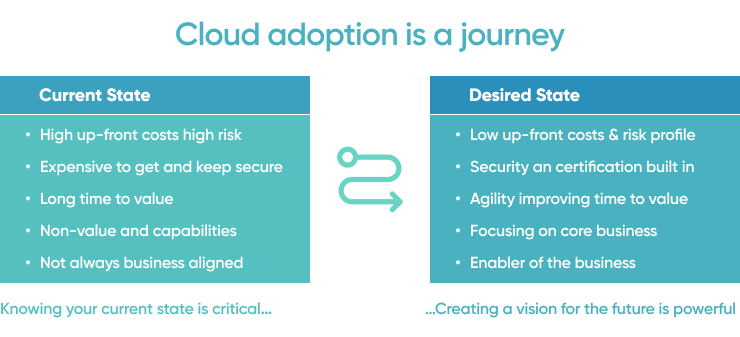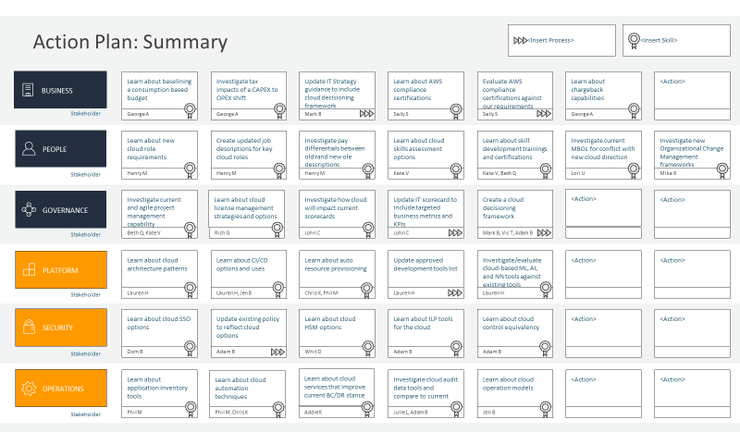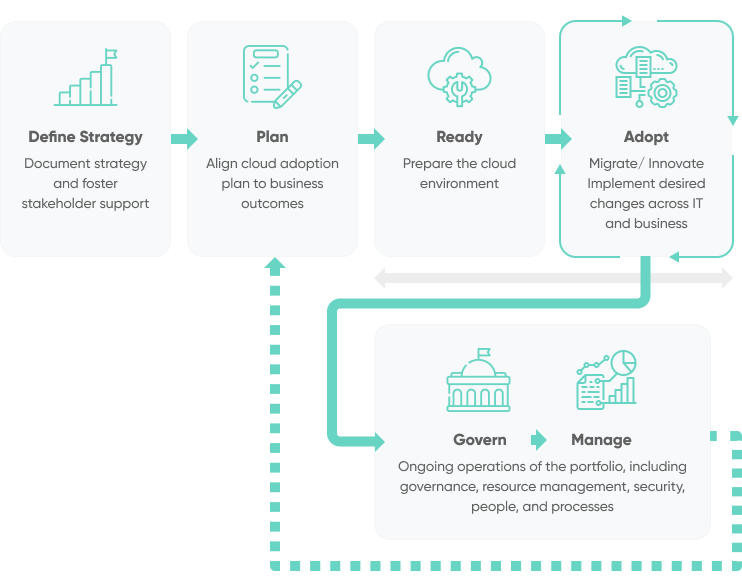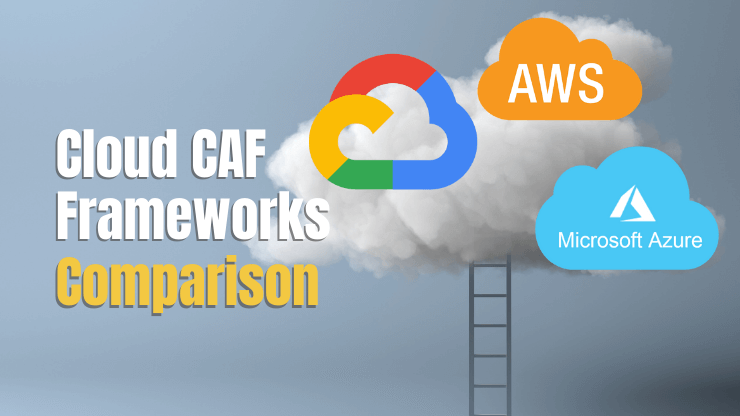Creating a cloud adoption plan and the cloud journey itself is a demanding process. Major cloud providers created Cloud Adoption Frameworks to accelerate your cloud adoption.
In this article, you will review business and technology strategies provided by CAF frameworks from AWS, Azure, and Google Cloud. In large part, they are technology agnostic. We’re here to help you understand how they can help you with successful cloud adoption.
What is the Cloud Adoption Framework?
Often companies begin their cloud migration journey without sufficient planning or strategy. Or they have a strategy, but they follow it selectively. Without visibility into their cloud services, business managers struggle to access and analyze data, preventing cloud adoption.
The Cloud Adoption Framework is a collection of documentation, implementation guidance, best practices, and tools that are proven guidance. Different cloud providers have their own Cloud Adoption Frameworks, which we cover in this article.
The key benefit of all Cloud Adoption Frameworks is that they help you build a solid cloud adoption plan. Its application is not limited to enterprises that are new to the cloud strategy. Businesses at any stage of their cloud journey can use it.

What are the key elements of the cloud adoption journey?
Every stakeholder should understand that cloud transformation will occur, and you are currently developing your cloud adoption action plans. When it comes to business plans, not everything goes according to plan. To overcome obstacles and increase the agility of the cloud adoption process.
Here are elements that will help you in accomplishing your cloud adoption goals:
Stakeholder goals analysis Bring all stakeholders together to ensure they are aligned with business objectives and to support transformation across all business functions.
Cloud Migration Strategy A well-defined and documented cloud-first strategy will persuade business teams of the benefits of cloud adoption and incentivize them to follow suit.
Organizational Change Process. You should define new business processes, operating models, training programs, and financial measurement methods to ensure that your business continues to operate smoothly as you migrate to the cloud.
Principles and Standards will guide your teams on how they should build, monitor, and iterate on new cloud environments. This way they will gain confidence and experience operating in the cloud. Guidelines, documentation, training, and testing can help.
Cloud Adoption Roadmap keeps all stakeholders on track during migration. Instead of long-term plans, start small, iterate, and evaluate. You'll constantly create new plans and update them to meet business needs. Small but consistent wins will also motivate business teams.
Cloud CAF frameworks comparison: Azure vs AWS vs GCP
Each cloud platform has its own set of best practices and tools. They are all grounded in the same principles and goals but differ in implementation.
AWS Cloud Adoption Framework
AWS Cloud Adoption Framework begins by identifying business stakeholders who are critical to cloud adoption. It divides stakeholders into six categories. These viewpoints enable your company to comprehend cloud adoption from the perspective of each stakeholder separately.
Each perspective specifies a set of capabilities, which are a collection of responsibilities managed by one or more functionally related stakeholders. Each capability clearly describes what a stakeholder owns or manages in the cloud adoption roadmap:
| Perspective | Function |
| Business Value Realization | Assists stakeholders in acquiring the knowledge necessary to boost their staff's skill set and upgrade organizational processes in order to maximize business value while migrating to the cloud. |
| People Roles and Readiness | Provides guidance to business managers on how to develop their people, technical capabilities, and improve their communications within appropriate time frames. |
| Governance Prioritization and Control | Acts as a guide to stakeholders charged with the responsibility of implementing technology to support business processes. Helps stakeholders in managing and measuring cloud investments in order to evaluate their business results. |
| Platform Applications and Infrastructure | Helps stakeholders to understand how to improve the skill sets of the staff and revitalize the organizational processes to deliver and optimize cloud and services. |
| Security Risk and Compliance | Assists stakeholders in upgrading staff skills and streamlining organizational processes to ensure that the cloud architecture deployed meets all applicable security and compliance requirements. |
| Operations Manage and Scale | Help stakeholders in upgrading workforce skills and reorganizing organizational processes in order to maintain system health during cloud adoption journey and then in operating using agile and cloud computing best practices. |
Your action plan will be based on the six perspectives defined here. One or more related stakeholders assigned to each AWS Cloud Adoption Framework perspective should convene on a regular basis to develop an action plan through iterations.
A cloud adoption action plan might look something like this:

To ensure cloud adoption success within your organization, you must ask specific questions and address concerns for each functional area in order to update your organization's skills and processes as you review each perspective. The simplest way to accomplish this is to define success criteria for each perspective at the organizational level, as well as the actions to be taken and potential roadblocks for each item.
Learn more AWS Cloud Adoption Framework
Azure Cloud Adoption Framework
Azure Cloud Adoption Framework is an iterative process. The phases should not be run only once but on an iterative basis. This emphasizes the statement that the Cloud Adoption Framework is available at any time. Regardless of where you are on your journey or how thoroughly and consistently you intend to go through the phases.

Azure Cloud Adoption Framework includes tools that assist you in implementing technical changes more quickly. Accelerate cloud adoption journey by utilizing these tools, templates, and assessments.
There are several ways to access the Cloud Adoption Framework, all of which can be found at Microsoft Cloud Adoption Framework for Azure.
If you have not yet started your journey, navigate to the "Begin your cloud journey" point. You will then be directed to the framework's beginning and Strategy phase. Carefully read the instructions and take the necessary steps.
Even if you have been successfully running your cloud environment on Azure for years, the Cloud Adoption Framework will be beneficial and enable you to improve. Microsoft has developed a "cloud journey tracker" for this purpose, which can be found under Microsoft Assessments.
You will then be questioned about each phase to ascertain your current location on your path. After you've answered all the questions, the assessment will provide an overview of your progress through each phase and indicate where you should take action.
Read more Azure Cloud Adoption Framework - Tools and templates
Google Cloud Adoption Framework
Google Cloud Adoption Framework establishes a structure based on people, processes, and technology that you can work with, providing a thorough assessment of your current state of cloud adoption journey and actionable programs to get you there. It is informed by Google's own cloud evolution and decades of experience assisting customers.
You can use the framework to assess your organization's cloud readiness and what you need to do to fill in the gaps and develop new skills. We're here to help you along the way. In order to drive innovation, you need a solid strategy to streamline internal operations and scale your brand. We can help you develop that strategy and guide you through the process.
Your readiness for cloud success is determined by the current state of your business practices in each of these four areas. These practices will fall into one of the following phases for each theme:

You can use the Google Cloud Adoption Framework yourself to make an assessment of your organization's readiness for the cloud, see Google Cloud Maturity Assessment
Once you've established your current state of cloud maturity, it's time to move forward. You will implement a number of workstreams to the scope and structure your cloud adoption program (which we call epics). The epics are defined in such a way that they do not overlap, they are aligned with manageable stakeholder groups, and they can be further broken down into individual user stories, which simplifies program planning.
Consider those epics through the familiar lens of people, technology, and process. If you're only able to tackle a subset of the epics, concentrate on the ones highlighted in color. These are the epics that correspond to Learn, Lead, Scale, and Secure; and thus, these are the epics that will define your journey to successful cloud adoption.

The three maturity phases, the four cloud adoption themes, and the epics comprise the framework Google Cloud uses to seamlessly guide customers to the cloud. The Cloud Maturity Scale helps you assess your cloud readiness. You can use the maturity scale and the epics with any cloud provider - the framework is technology agnostic.
Learn more on Google Cloud Adoption Framework
SoftKraft Cloud Migration Services
Drive value and focus on business growth with full control of your data, applications, and workloads by deploying scalable and secure architecture on the cloud.
SoftKraft Cloud experts simplify all your cloud migration and operations. We make sure that data center migrations take place in a smooth, effective, and streamlined manner without any negative business impact.
| Cloud Migration Planning Our cloud experts ensure that the cloud adoption journey is done with maximum efficiency, zero downtimes, optimum costs, and control. | Cloud Migration Best Practices Our cloud assessment and migration services ensure greater agility, security, and consistency to meet the needs of your business today and tomorrow. |
| Replatforming Applications for Cloud We can advise you when to apply Lift And Shift strategy and when to refactor your application to leverage cloud features. | From Monolith to Microservices The monolith-to-microservices restructuring is performed as incremental refactoring of legacy applications and adding new microservices to the existing application. |
| Cloud Infrastructure Automation Automate infrastructure and cloud configuration management to deliver greater system confidence, less risk and more time for your team. | CI/CD Pipelines Configuration Whether it is Jenkins, Concourse or any other tool - CI/CD solution is a nervous system of the IT behind your business. |
Conclusion
The path to cloud adoption strategy varies by company. To successfully implement it within your organization, you must understand in-depth the current state of your business, goals, and the shift required to achieve your business objectives. With this information, you can set up goals and workstreams for your team to accomplish in the cloud.
To ensure a seamless cloud adoption, keep your stakeholders informed of the desired business outcomes. To become more agile in the cloud, the cross-team collaboration will help you automate cloud environment and infrastructure changes.

